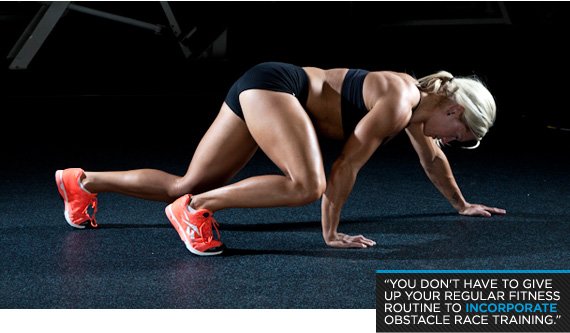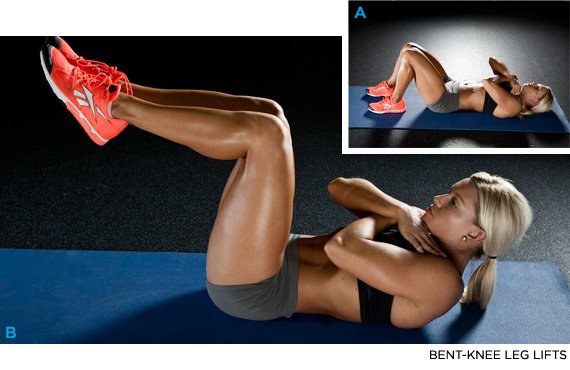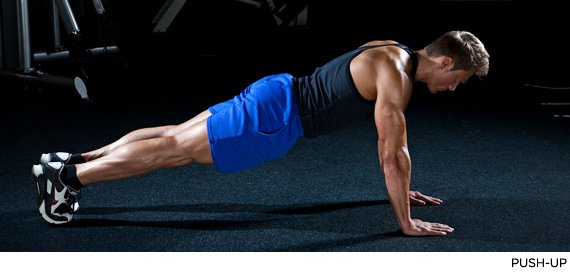Obstacle races present unique pitfalls designed to exploit your weaknesses and leave you face down in the mud. To win the war, you need to crush these battles.
Practicing the actual obstacles can help you prepare, but no amount of practice can mimic race day's toxic combination of fatigue, adrenalin, and mud. Instead, try unique workouts that target the specific movements and skills you need to overcome an obstacle, while also maximizing your overall stamina and coordination.

You don't have to give up your regular fitness routine to incorporate obstacle race training. Instead, you can add individual obstacle-specific workouts to your existing program. Start by focusing on 2-or-3 obstacles. On Mondays, add the Balance Beam workout to the end of your regular routine. Mix in the Haul & Carry workout on Wednesdays, and set aside Saturdays for the Hill Climb workout. If you don't have an existing fitness regimen or want to set aside a few months to focus all your energy on your upcoming obstacle race, you can adopt a more comprehensive approach: divide the workouts into days of the week and attack them all.
When you adopt my obstacle-specific training program, focus on obstacles that are particularly challenging for you. If you can crush the balance beam workout, skip it and incorporate one of the other workouts that are much more difficult for you.
I run an obstacle-race-specific training website, ConquerAnyCourse.com, and my upcoming book, The Obstacle Race Training Bible: The #1 Resource To Prepare For & Conquer Any Course! will be published by Penguin/Alpha in December, 2012. In the meantime, I'm here to share my expertise with you in this article.
Lunge 'Til You Drop
To do well on the balance beam, you need to master your body's stabilization mechanisms. Good balance ultimately comes down to training your abdominal muscles and central nervous system to stay upright while moving. Lunges are a great way to train these skills.
While lunging, never squat so low that your back knee touches the ground. Also, stabilize your hips when you're in the lunge, particularly when adding upper body movements. Finally, practice keeping your head upright and your eyes pointed forward throughout the exercises—no looking down at the ground. On the beam, one downward glance could jeopardize everything.
You can split this workout into sections and do sets of 10-12 until you complete 50 repetitions. It really doesn't matter what the set structure is, as long as you do 50 reps of each type of lunge. By doing 150 reps of lunges, you're putting your abdominal muscles under stress for an extended period of time, which is exactly what you need to navigate a wobbly beam spanning a pit of mud or chilly water.
For best results, carry dumbbells or hold a barbell across your shoulders for each type of lunge. Train along a track or a sidewalk, where you can move from one lunge to the next without stopping.

Because tissue elasticity plays such a crucial role in lunges, always stretch before doing these exercises. Spend ten minutes stretching your calves, anterior thighs, abductors and adductors, glutes and hamstrings. I recommend a dynamic stretching protocol, where you actively stretch and release rather than stretch and hold. The active movement will add flexibility to muscle and connective tissue and will initiate stimulation of the muscle fibers. Static stretching helps your muscles relax—which is the last thing you want just before this workout!
The following exercises will help you prepare for the balance beam obstacle on any race course. Once you've mastered these exercises, you'll be able to master the beam.
Grasp light dumbbells or weights with each hand. From a standing position, extend a leg to one side, squat down low (keeping your body weight in your heels), and hold the position for 2 to 3 seconds. While in the squat, gently twist your core back and forth or raise the weights above your head and back down to perform a shoulder raise. Raise yourself back up to a standing position and repeat.
(1 set of 50 reps)
Start from standing while holding weights, and step either forward or backward and perform a lunging motion. Hold the motion for 2 to 3 seconds and do gentle twists or shoulder raises.
Start from a standing position, but this time twist before lunging. Imagine your hips as the center of an X with your arms and legs forming the arms of the X. Twist in the opposite direction each time.

Get Low For The Cargo Net
Climbing or crossing a giant net made out of rope may look like kid stuff, but cargo nets take a toll on your entire body. The bigger the net the more difficult, especially on flimsy nets positioned horizontally or at a low angle (the more vertical the net, the easier it is to climb). Every time you or someone else on the web moves, the whole thing sways and jiggles—I call it the "waterbed effect." If you're not careful, you'll expend more energy and time clinging to the rope than crossing it.

To conquer the cargo net, you need to do exercises that engage every muscle in your body. You need to learn how to maintain your balance while continuously shifting your hands and feet to make forward progress.
I recommend performing this workout in a relatively padded location. If you can't find one, wear knee pads instead. Do all of these exercises at a fast pace with quick, controlled movements. If you're new to this style of training, start slowly and increase your pace as you get the hang of it.
Do some light cardio to get the blood flowing and your joints and tendons ready for bursts of action.
- Place a pair of dumbbells on the floor. Get down in a sumo stance, dipping your butt low and putting tension on your thighs and glutes. The deeper you squat, the more endurance you build in your legs.
- While maintaining the low sumo squat, circle the dumbbells by doing side lunges.
- After each 10 seconds of lunges, drop down to the floor and do a dumbbell pushup. After the pushup, do one dumbbell back row per arm, and then do another pushup. This sequence of exercises keeps your upper body muscles engaged during the circle squats.
- Return to the sumo squat position, and continue circling the dumbbells. Do this for one minute, then rest for 25 seconds. After your rest repeat for another minute, take a 40 second rest, and then do the rotation one last time. All told, you should do three minutes of this exercise.
Carry The Fire
When it comes to training for the haul and carry, you want to develop power. Just as importantly, you need to take measures to reduce the risk of injury to your lower back, hips, and pelvic area. You can do this by strengthening those areas while also practicing proper technique for lifting and carrying heavy objects.
I recommend minimizing the rest period between sets in this workout. On race day, you'll feel the difference in the form of extra strength, endurance, and explosive power.
Make sure you pay special attention to stretching your hip complex to reduce tightness. Kneeling, standing, or supine hip flexor stretches are great ways to hit those tight hips, as are yoga poses like butterfly or pigeon pose.

The following exercises will help you train for the haul and carry. They're designed to build power, strength and stamina.
Hold the weight plate close to your chest at the nipple line to reduce the stress on your lower back. With your core flexed tightly, lower into a squat and then raise yourself up. At the top of the squat, raise the plate over your head and then lower it down between your legs. Keep your back stiff and straight, your head up, your weight in your heels, and your core engaged. Also, try to keep the plate close to your body as you raise and lower it. Lower yourself back down into the bottom of the squat.
From a standing position, go into deep side or front lunges while holding a weight plate. At the bottom of each lunge, twist your torso back and forth. Don't swing the weight; instead, move it purposefully by engaging your frontal and oblique abdominal muscles.
Lie on your back with your hands grasping the weight above your chest. Raise your arms and extend the plate as far back above your head as your arms can reach. Simultaneously lift the weight and your legs from the floor and bring them together above your chest. Slowly lower your feet and the plate back to the start position, but don't let your heels or the plate touch the ground. For a greater challenge, place a dumbbell between your feet.

Sprint For Hill-Climb Success
No single exercise can prepare the central nervous system and musculature for the challenge of bounding up steep hills. Instead, you need a routine of compound exercises that includes mountain climbers, bodyweight squats, and sprints.
Do a brief warm-up of jumping jacks, slow jogging, or jumping rope.

Sprints
15 sets of 100 meters

Air Squats
15 sets of 30-50 reps
Sprints
15 sets of 100 meters

Mountain Climbers
15 sets of maximum reps in 1 minute

Hop To The Top!
To really haul ass over the hurdles, you need a combination of dexterity and explosive lower body bursts. The ideal training program combines agility drills and endurance exercises. Agility drills train you to be light on your feet and to quickly and safely change directions. Combine agility with stretches of jogging, tuck jumps, and sprints, and your body will be ready for any kind of hurdle!
If you have access to a track, use it for this workout. If you don't, anywhere with a long stretch of grass or pavement will do. Use cones, chalk, rocks, or other objects to mark the agility drill area.
Be sure to stretch and drink lots of water before doing this workout.

Sprints
3 sets of 200 meters (down-and-back)

Tuck Jump
6 sets of 12 reps, interspersed with sprints
After sprint workout, perform the following agility drill.
- Mark off four corners of a square; markers should be three feet apart. (If you're taller, square should be bigger.) Place another marker in the center of the square.
- Start in the middle of the square and hop, with your feet together, to one of the outside markers. Immediately hop back to the middle and then hop to a different corner of the square.
- Perform 25 to 35 hops.
Hang On To Win
When you're staring down a long set of monkey bars and time is on the line, you not only need strong arms and back muscles, but overall muscular endurance as well. A lot of people prepare for monkey bars by doing lat pull downs and barbell curls, but that's not enough. You need exercises that demand endurance, build lean mass, and increase your cardiovascular system's ability to deliver quick, controlled movements.
Because this exercise is so challenging, I don't recommend doing sets. Instead, choose a reasonable number of reps and try to reach it. For beginners, try doing 25 as quickly as possible. If you're more athletic, shoot for 50 reps.
To achieve best results, change your grip with each rep. Start out with the military overhand grip, then switch to an underhand grip, a staggered grip, and a wide grip. For extra hand and wrist endurance, hang from pull-up bars and walk your hands laterally, one hand over the other.
Do a short jog and be sure to stretch your lats.
- From a standing position directly beneath the pull-up bar, jump up and power your upper body as far above the bar as possible. For most people, the bar will be slightly below the chin. Hold this position.
- Bring your knees into your abdomen and lower them back down, repeating the motion as many times as you can. Keep your lower abdomen engaged the entire time. Once you're done with knee raises, drop down to the ground—that's one rep.
Jump Around!
Hopping from stump to stump without touching the ground challenges your balance and your lower body agility. Some obstacle races feature extensive stump jump sections, calling for truckloads of stamina and muscle endurance. 
Often, the stumps are wobbly, requiring superhuman stabilizing skills to stay upright. This obstacle can be particularly taxing on your calves. An obstacle like the stump jump demands an equally challenging training regimen.
For an extra challenge, do multiple box jumps in rapid succession. For even more fun, use light dumbbells to add some resistance to your hand raises.
- Burpee to Box Jump: 5 sets of 8-10 reps, 20-40 second rest period
- In the middle of your burpee (while you're in the plank position), lift one hand and the opposite leg from the ground, and balance for 5 seconds. Repeat with the opposite hand and foot.
Just Grip It!
For many obstacle enthusiasts, the wall is a daunting spectacle to behold. You obviously need strong legs, core, and upper back muscles, but they'll only get you so far up. More than anything, you need a strong grip. To effectively train for this obstacle, choose a full-body cardiovascular endurance exercise that puts special emphasis on your hands—like the row. 
When rowing, sit up tall and with a straight back, keep your head up, and avoid crouching into your knees. On the way back, engage your lower back; on the way forward, engage your core. Set the resistance to high. For men, it should be as high as it can go. For women, resistance should be in the top third levels.
To increase the rowing challenge, grip the handles extra-tight. The sooner your hands start to sting, the better. You want to push your hand muscles beyond what they're accustomed to. That way, they'll be prepared to climb faster and more efficiently. Minimize rest as much as possible. Your hands, forearms and wrists should be burning beyond belief.
Stretch your forearm muscles before starting this routine to help prevent hand cramps during the workout.
Crawling Toward Victory
A good way to train for an obstacle is to practice on a simulated version of it. An even better approach is to make the simulated version more difficult than the real deal. By adding weights to your load as you simulate maneuvering through a tunnel, race day will be a breeze.
Use moderately-weighted dumbbells—the crawls should be challenging! For the sumo walks, try a 25-pound plate. If you find it too easy or difficult, adjust. To significantly increase the difficulty of this routine, wear a weighted vest.
Before beginning, do some basic leg and upper body stretches. Make sure to hit the chest, triceps, hamstrings, thighs and lats. Do a short bout of cardio to warm up the tendons and ligaments for the awkward movements and stances in the workout.
The following exercises will help you train for tunnel obstacles. Once you can complete this workout with ease, you'll tunnel faster than a caffeinated gopher.
Lay on the floor with your hands on the dumbbells in a pushup position. Lean your body forward so that you can lift a dumbbell with one hand and scoot it ahead a few feet. Always try to execute a full row when picking up and moving the dumbbells. Continue crawling forward by alternating arms. Do a push-up between crawls.

Grasp a weight plate in both hands, holding it directly above your head or close to your chest to protect your lower back. Squat down low like a sumo wrestler and, without resting your elbows on your knees, walk with wide steps, remembering to staying low in the squat.
Perform these two exercises in a superset.
Hit The Wall
At climbing clubs and gyms, you wear a harness and vest when attempting a wall traverse. During obstacle races, you're on your own. You need to be ready to jump onto the wall and start climbing freeform. This obstacle requires special core, upper back, arm, and shoulder training.
Cable machines do a good job of mimicking the natural movements you perform on a wall traverse. You can use the machine continuously in a circuit fashion to increase your endurance. Choose a machine that has separate cables for each hand and adjustable arms.
Keep your core nice and tense through every rep. You can keep a fairly quick tempo because the weight will be set to a moderate setting. Do the exercises back to back and try to cut out as much rest as possible. When rest does becomes necessary, and for most people it will, try not to exceed 15-30 seconds. Rest during training translates into potential defeat on the course. If your legs get tired before your upper body fatigues, increase the weight.
Move around to get your blood flowing and your joints loosened. Pay special attention to your rotator cuff. Perform 20 shoulder rolls, 10 backward and 10 forward; 20 full arm rolls, 10 backward and 10 forward; and 20 torso twists with loose arms.


Kneeling Cable Lat Pull-Downs
3 sets of 25 reps each arm

Cable Forearm Push-Downs
3 sets of 25 reps each arm

Cable Front Raises
3 sets of 25 reps each arm




